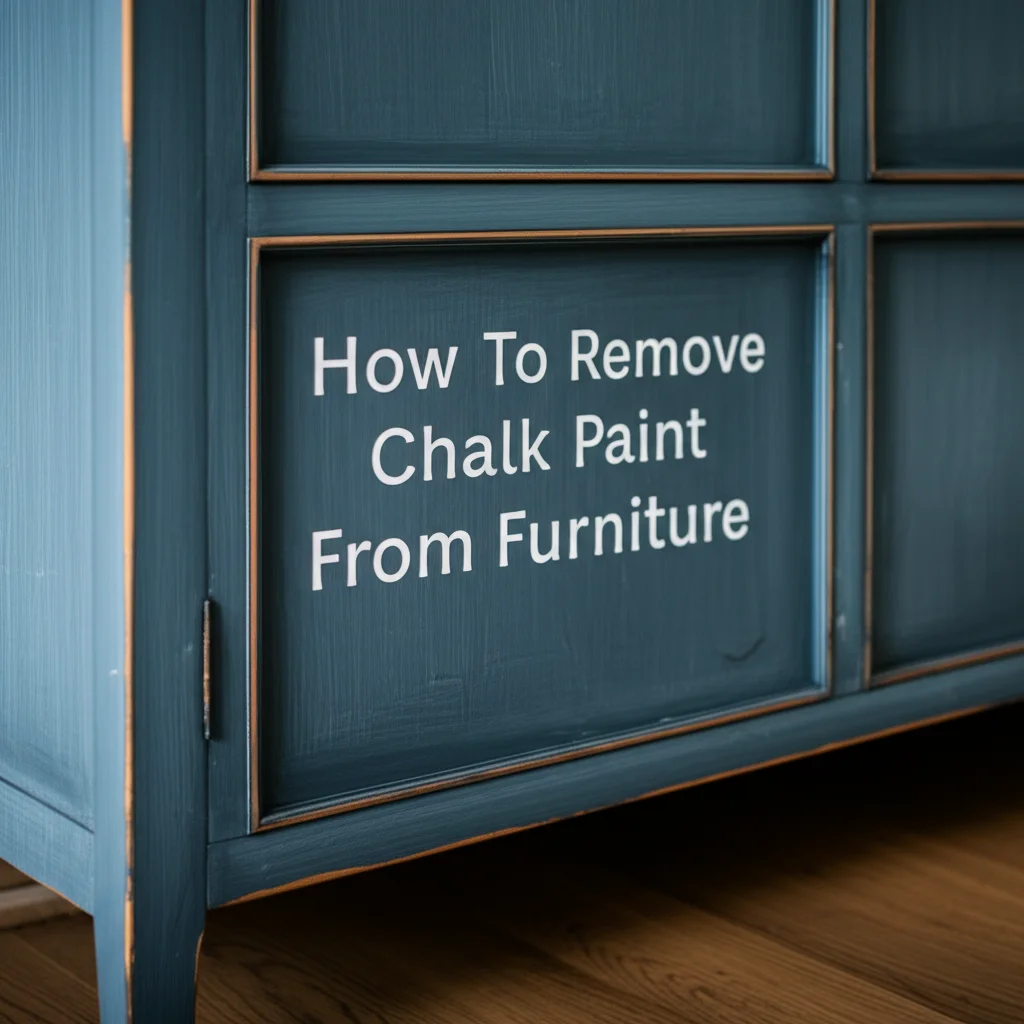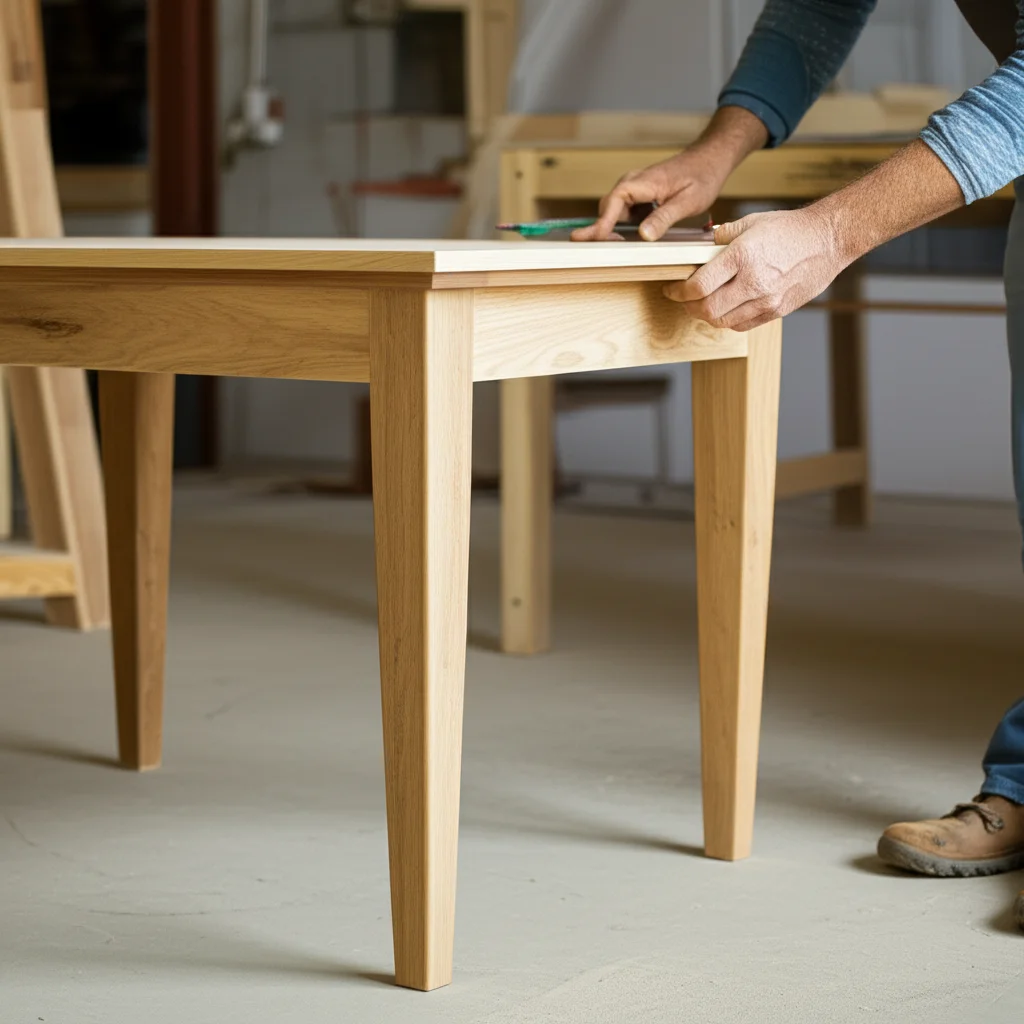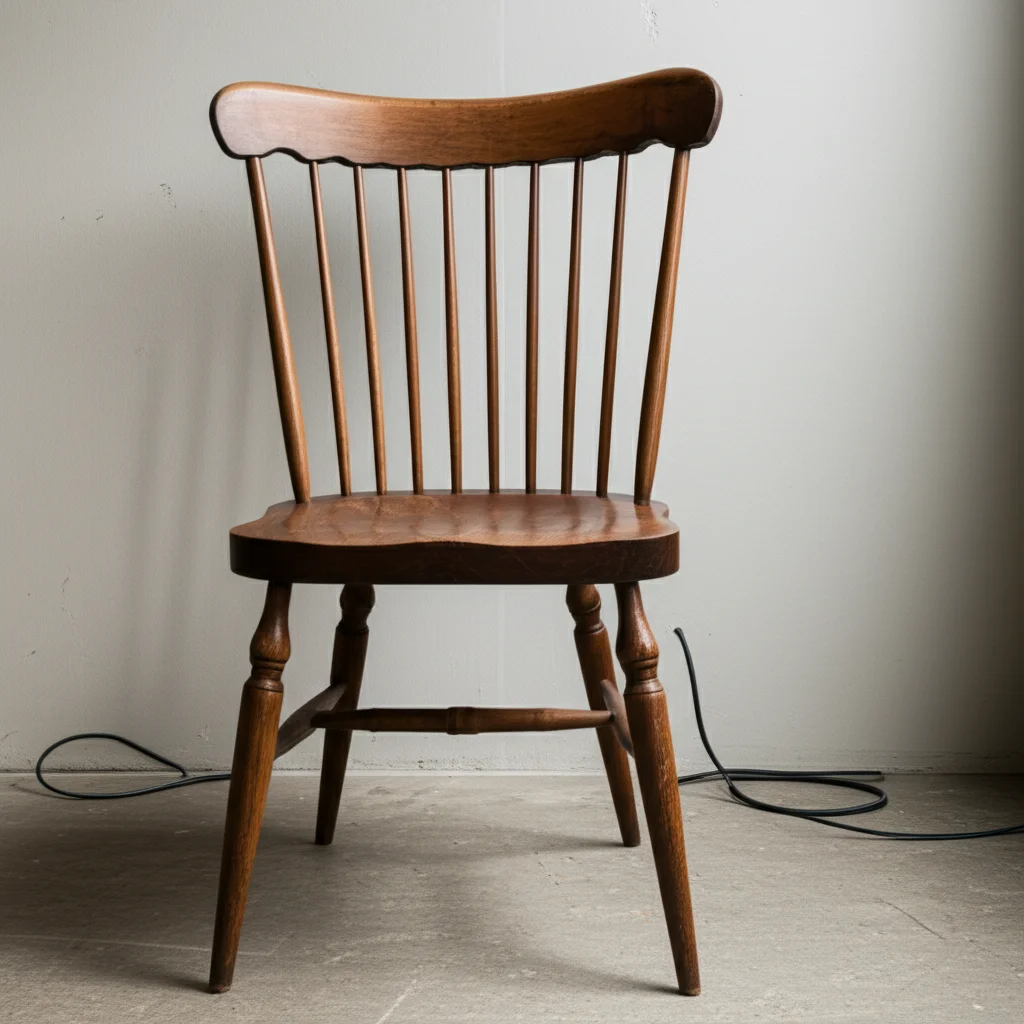· Todd Martin · Furniture Restoration · 16 min read
How To Remove Chalk Paint From Furniture

How To Remove Chalk Paint From Furniture Effectively
Have you ever fallen out of love with a piece of chalk-painted furniture? Perhaps the color no longer suits your home, or you simply want to return it to its original beauty. Removing chalk paint from furniture can seem like a daunting task, but it is entirely achievable with the right techniques and patience. We will guide you through several effective methods to strip away chalk paint, revealing the potential beneath. This article covers everything from gentle cleaning to chemical stripping, ensuring you can successfully update or restore your beloved furniture pieces.
Takeaway
- Assess the furniture: Understand the underlying material and condition to choose the best removal method.
- Prepare your workspace: Ensure good ventilation, protective gear, and a clear area.
- Choose a method: Select between chemical strippers, sanding, or heat guns based on paint thickness and furniture type.
- Address wax topcoats first: Remove any wax sealant for easier paint removal.
- Clean and prep the surface: Thoroughly clean and sand the furniture after paint removal, preparing it for a new finish.
To remove chalk paint from furniture, start by determining if a wax topcoat is present and remove it with mineral spirits. Next, choose between mechanical sanding, chemical paint strippers, or a heat gun, applying the chosen method carefully and patiently. Finally, clean the stripped surface thoroughly and lightly sand it to prepare for a new finish.
Understanding Chalk Paint and Why Removal Matters
Chalk paint is a popular choice for furniture makeovers due to its matte finish and minimal prep requirements. It adheres well to many surfaces without much sanding or priming. Despite its ease of application, there are many reasons why you might want to remove chalk paint from furniture. The paint might be chipped, showing signs of wear, or you simply desire a different aesthetic for your home.
Sometimes, the original chalk paint job might not have been done correctly, leading to an uneven finish. Or, you might want to restore a vintage piece to its original wood glory. Understanding the nature of chalk paint is key to its successful removal. It is a porous, water-based paint, often sealed with wax or a clear coat, which impacts how you approach its removal. We aim to remove chalk paint efficiently, ensuring the underlying furniture remains in good condition.
The most common reason for wanting to remove chalk paint is to change the look. Trends shift, and what was once a perfect color may no longer fit your decor. Perhaps you inherited a piece of furniture and want to give it a fresh start. Stripping away the old paint allows you to discover the hidden beauty of the wood underneath. It also provides a clean slate for a new coat of paint or stain.
Effective chalk paint removal also prevents future adhesion issues if you plan to repaint the furniture. Residual paint can cause new layers to peel or chip prematurely. Taking the time to properly remove chalk paint from furniture ensures a durable and beautiful new finish. This process is an investment in the longevity and appearance of your furniture.
Gathering Your Tools for Chalk Paint Removal
Before you begin to remove chalk paint from furniture, gather all necessary tools and materials. Having everything ready saves time and ensures a smooth removal process. Safety should always come first, so personal protective equipment is essential. You will be working with paint, dust, and potentially chemicals, so protect yourself.
Here is a list of essential items you will need:
- Safety Gear:
- Gloves (nitrile or chemical-resistant)
- Safety glasses or goggles
- Respirator or dust mask (especially for sanding or chemical stripping)
- Old clothes or an apron to protect your attire
- For Wax Removal (if applicable):
- Mineral spirits or denatured alcohol
- Clean rags or old towels
- For Chemical Stripping:
- Paint stripper (choose a non-toxic, eco-friendly option if possible)
- Metal or plastic container for stripper
- Natural bristle brush for applying stripper
- Plastic scraper or putty knife
- Steel wool (fine grade)
- Heavy-duty plastic sheeting or tarp to protect your workspace
- For Sanding:
- Orbital sander or sanding block
- Assorted grit sandpaper (80, 120, 150, 220 grit)
- Dust collection system for sander or shop vacuum
- For Heat Gun Method:
- Heat gun (with multiple temperature settings)
- Metal scraper or putty knife
- Cleaning Supplies:
- Mild detergent or degreaser
- Clean water
- Sponges or clean cloths
- Bucket
Prepare your workspace by laying down plastic sheeting or a tarp to protect your floors from paint chips, dust, and stripper. Ensure the area is well-ventilated, either outdoors or with open windows and fans. Good airflow is crucial when dealing with paint fumes and dust. Once your space is set up and your tools are within reach, you are ready to tackle the chalk paint.
Chemical Stripping: An Effective Method for Removing Chalk Paint
Chemical stripping is a highly effective way to remove chalk paint from furniture, especially for intricate pieces or when dealing with multiple layers of paint. This method works by breaking down the paint’s bond with the surface, allowing it to be scraped off easily. While effective, it requires careful handling due to the nature of the chemicals involved. Always read the stripper manufacturer’s instructions and safety warnings before you begin.
Before applying the stripper, you might need to remove any wax topcoat that was applied over the chalk paint. Wax can act as a barrier, preventing the stripper from penetrating the paint effectively. To remove wax from your chalk-painted furniture, simply dampen a rag with mineral spirits or denatured alcohol and wipe the surface thoroughly. You can learn more about this process in our guide on how to remove wax from chalk painted furniture. This initial step ensures the chemical stripper can do its job properly.
When you are ready, apply the chemical stripper generously to a small section of the chalk-painted furniture using a natural bristle brush. Ensure the entire painted area is covered evenly. Allow the stripper to sit for the recommended time, usually 15-30 minutes, or until the paint begins to bubble and soften. Do not let the stripper dry on the surface; reapply if needed to keep it wet.
Once the paint has softened, use a plastic scraper or putty knife to gently lift and remove the paint. For detailed areas, use fine steel wool or an old toothbrush. Work in small sections, moving the loosened paint onto your protective tarp. After removing the bulk of the paint, clean the surface with a rag dampened with mineral spirits or a stripper wash recommended by the manufacturer. This neutralizes any remaining chemicals. Remember to dispose of the paint waste and rags properly according to local regulations.
Finally, after the paint is removed, wipe down the furniture with a mild detergent and water to remove any residual stripper or residue. Allow the furniture to dry completely. A clean surface is essential for any future finishing steps. This method is excellent for getting into all the nooks and crannies of furniture.
Sanding Down Chalk Paint: A Mechanical Approach
Sanding is a straightforward and widely used method to remove chalk paint from furniture. It is a mechanical process that physically grinds away the paint layers. This approach is particularly effective for flat surfaces and can be less messy than chemical stripping if you use a sander with a dust collection system. However, it requires care to avoid damaging the underlying wood.
Before you begin sanding, especially if there’s a wax topcoat, you might find it beneficial to remove the wax first. While sanding can eventually get through wax, it can gum up your sandpaper quickly. A quick wipe with mineral spirits to remove the wax will make the sanding process much more efficient. Once any wax is dealt with, you are ready to sand.
Start with a coarse grit sandpaper, such as 80-grit, to remove the bulk of the chalk paint. If using an orbital sander, move it constantly over the surface in overlapping circles to prevent creating grooves or uneven spots. For areas difficult to reach with a power sander, use a sanding block or hand-sand. Apply steady, even pressure. As the paint comes off, you will see the bare wood emerge.
Once most of the paint is gone, switch to a finer grit sandpaper, such as 120-grit, then 150-grit, and finally 220-grit. Each successive grit refines the surface, removing sanding marks from the previous, coarser grit. This step is crucial for achieving a smooth, uniform surface ready for a new finish. Always sand in the direction of the wood grain when using finer grits to minimize scratches.
After sanding, thoroughly clean the furniture to remove all dust. Use a shop vacuum with a brush attachment, followed by a tack cloth or a damp cloth. Ensuring the surface is free of dust is vital for good adhesion if you plan to repaint or stain. This mechanical approach is efficient and gives you direct control over the removal process.
Heat Gun Method: Loosening Stubborn Chalk Paint
Using a heat gun is another effective method to remove chalk paint from furniture, especially for stubborn layers or multiple coats. A heat gun works by heating the paint to a high temperature, causing it to soften and bubble, making it easy to scrape off. This method is particularly useful for large, flat surfaces and can be faster than sanding for thick layers. However, it requires careful handling to prevent scorching the wood.
Before you begin, ensure your workspace is well-ventilated. Have a metal scraper or putty knife ready. Hold the heat gun a few inches from the chalk-painted surface, moving it slowly and steadily over a small area. You will see the paint begin to soften, wrinkle, and bubble. Do not hold the heat gun in one spot for too long, as this can burn the wood. The goal is to heat the paint just enough to soften it, not to burn it.
As the paint softens, immediately use your scraper to gently lift and remove it. The softened paint should come off in sheets or flakes. Scrape in the direction of the wood grain whenever possible. For detailed areas or carvings, use smaller scraping tools or even stiff wire brushes designed for paint removal. Continue working in small sections, moving the heat gun and scraping simultaneously.
Exercise caution when using a heat gun. It generates intense heat that can cause burns or ignite flammable materials. Keep the heat gun moving and direct the heat away from yourself and anything combustible. After removing the paint, the underlying wood may feel warm. Allow it to cool completely before proceeding to the next steps.
Once all the chalk paint is removed using the heat gun, the furniture surface may still have some residue or slight irregularities. You will need to lightly sand the entire piece with fine-grit sandpaper (e.g., 150-220 grit) to smooth out the surface and prepare it for a new finish. This final sanding step ensures a perfect base for repainting or staining. Always clean the dust thoroughly after sanding.
Natural Alternatives for Removing Chalk Paint
While chemical strippers, sanding, and heat guns are effective, some people prefer natural or less aggressive methods to remove chalk paint from furniture. These alternatives are often safer for you and the environment, though they may require more time and effort. They are particularly suitable for thinner coats of paint or for those who prefer to avoid harsh chemicals.
One common natural alternative is a mixture of vinegar and water. Vinegar is a mild acid that can help soften water-based paints like chalk paint. To use this method, mix equal parts white vinegar and warm water in a spray bottle. Generously spray the chalk-painted surface, ensuring it is thoroughly saturated. Allow the mixture to sit for 15-30 minutes, keeping the surface wet by reapplying if necessary. After the soaking period, use a plastic scraper or stiff bristle brush to scrub and remove the softened paint. This method might require multiple applications and more elbow grease than stronger strippers.
Another option is to use rubbing alcohol or denatured alcohol. Similar to vinegar, alcohol can break down the bond of water-based paints. Apply rubbing alcohol to a clean cloth and vigorously rub the chalk-painted surface. You should see the paint start to dissolve or lift. This method is often effective for smaller areas or lighter coats of chalk paint. For tougher spots, you can apply alcohol directly and let it sit for a few minutes before scrubbing.
For pieces with a wax topcoat, mineral spirits are an excellent natural solvent. As mentioned earlier, mineral spirits effectively dissolve wax, making the underlying chalk paint more accessible for removal. You can find more detailed instructions on cleaning furniture using mineral spirits, which can also help with residue, by looking at resources such as how to clean wooden furniture. This approach helps prepare the surface for subsequent natural paint removal.
After using any natural method, always clean the furniture thoroughly with clean water and a mild soap solution to remove any residue from the vinegar or alcohol. Let the furniture dry completely before moving on. While these methods are gentler, they are effective steps to remove chalk paint from furniture without resorting to harsh chemicals.
Post-Removal Care and Furniture Preparation
After you successfully remove chalk paint from furniture, the job is not entirely done. The post-removal care and preparation steps are critical for achieving a beautiful and durable new finish. Skipping these steps can lead to adhesion issues for new paint or stain, or an uneven final appearance. Taking the time now ensures your efforts pay off in the long run.
First, thoroughly clean the stripped furniture surface. This step removes any remaining paint residue, dust, or chemical stripper. Use a clean cloth dampened with mineral spirits or a specialized cleaner appropriate for the stripper you used. Follow this with a wipe-down using a mild detergent and water solution. Rinse with clean water and allow the furniture to dry completely. A clean surface is essential for proper adhesion of any new finish. You can also refer to how to clean furniture before painting for detailed cleaning protocols.
Next, inspect the furniture for any imperfections. Paint removal can sometimes reveal underlying damage or create minor blemishes. Use fine-grit sandpaper (e.g., 150-220 grit) to smooth out any rough spots, scratches, or remaining paint specks. Sanding ensures a uniform surface texture. If you plan to stain the furniture, ensure all previous finishes are completely gone, as any residue will prevent the stain from absorbing evenly. For areas where paint might have chipped before removal, or if you found minor dings, you might want to look into methods on how to fix chipped paint on wood furniture for general repairs, though here you are dealing with bare wood.
After sanding, remove all sanding dust from the furniture. Use a shop vacuum with a brush attachment, followed by a tack cloth or a lint-free cloth lightly dampened with mineral spirits. This ensures a dust-free surface, which is vital for a smooth new finish. Any dust left behind can create bumps or an uneven appearance under paint or stain.
Now, your furniture is ready for its new chapter. You can apply a fresh coat of paint, a beautiful wood stain, or a clear protective finish to highlight the natural wood grain. Consider what look you desire for the piece. If you are unsure about colors, guidance on how to decide what color to paint furniture can help with your next design choice. Properly preparing the surface ensures that whatever new finish you choose will adhere well and last for years.
FAQ Section
Can I remove chalk paint with just water?
Chalk paint is water-based, but simply water is usually not enough to remove it once it has cured. While fresh chalk paint can be wiped away with a damp cloth, cured paint requires more aggressive methods. You need to use mineral spirits for wax removal or chemical strippers, sanding, or a heat gun for the paint itself. Water alone will only lightly clean the surface, not strip the paint.
Is chalk paint removal difficult?
The difficulty of removing chalk paint depends on several factors. These include the number of paint layers, the type of topcoat (like wax), and the furniture’s intricate details. It can be time-consuming, but with the right tools and techniques, it is a manageable DIY project. Patience is key, especially for detailed pieces or multiple paint layers.
What is the best method to remove wax from chalk-painted furniture?
The best method to remove wax from chalk-painted furniture is by using mineral spirits or denatured alcohol. Apply the solvent to a clean rag and rub the waxed surface firmly. The wax will dissolve and transfer to the rag. Repeat this process until all the wax residue is gone, ensuring the surface is clean and ready for paint removal.
Can I repaint over chalk paint without removing it?
Yes, you can often repaint over chalk paint without fully removing it, especially if the existing chalk paint is in good condition. However, it is essential to clean and lightly scuff-sand the surface first to ensure proper adhesion for the new paint. If the existing chalk paint is chipped, peeling, or uneven, removing it entirely provides a better foundation for a smooth and durable finish.
How long does it take to remove chalk paint from a piece of furniture?
The time it takes to remove chalk paint from furniture varies greatly depending on the furniture’s size, its complexity, the number of paint layers, and the chosen removal method. A small, simple piece might take a few hours. A large, intricate dresser with multiple coats could take a full day or even longer, spread across several sessions.
What should I do if paint stripper damages the wood?
If paint stripper leaves a residue or slightly discolors the wood, you can try cleaning the area with mineral spirits followed by a dilute solution of white vinegar and water. For minor discoloration, light sanding with fine-grit sandpaper may help. If the damage is significant, you might need to use wood filler and then sand the area smooth before applying a new finish.
Conclusion
Deciding to remove chalk paint from furniture is a significant step towards transforming your living space or restoring a cherished piece. As we have explored, whether you choose chemical strippers, the mechanical power of sanding, or the targeted heat gun method, each approach offers a viable path to a clean slate. Remember, preparing your workspace and prioritizing safety are as important as the removal process itself. Always take the time to clean and prep the surface meticulously after stripping, as this sets the stage for a flawless new finish.
You now have the knowledge and techniques to confidently remove chalk paint from furniture. This process can be incredibly rewarding, allowing you to reveal the natural beauty of wood or prepare for a completely new design. Don’t be afraid to experiment with different finishes once the paint is gone—your creativity is the only limit. Are you ready to give your furniture a fresh start and breathe new life into your home? Begin your furniture restoration journey today and discover the endless possibilities.
- chalk paint removal
- furniture restoration
- stripping paint
- DIY furniture
- wood furniture
- refinishing furniture





